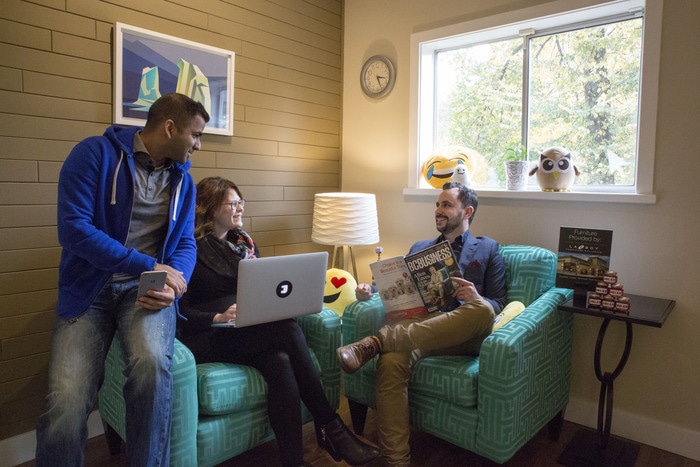How ‘Virtual Vivian’ Generated $400K Teaching People How to Become Virtual Assistants

Despite getting a university degree in business and landing a stable 9-5 office job, Vivian Garcell craved more. “I did all the right things, but I didn’t feel fulfilled,” shares Garcell. “I just wanted to work from my laptop and take my work with me.”
She dreamed of working remotely and traveling the world. In 2016, she quit her corporate career and became a freelance virtual assistant. When friends started asking how they could do the same, she had the idea to create her own online content teaching them to do so under the brand Virtual Vivian. Drawing on her experience making courses for clients, she built and marketed her first course: Virtual Freelancer Academy.
$400k
in revenue over 2 years
125k
TikTok followers
25k+
email subscribers
Since, she’s lived her dream by taking two, six-month trips around Canada and the US. “I even had online course enrollments come in while I was at a spa in the Rockies!” she shares.
Here’s how Garcell created, marketed, and sold her online course—resulting in over $400K in revenue in just two years.
Skip ahead:
- She validated her course concept
- She signed up with Thinkific
- She created viral TikTok content
- She launched her online academy
- She created value-packed lead magnets
- She committed to her niche
- She put herself out there—even as an introvert
- She priced her course according to its value, not its length
- She stayed consistent
- She let go of perfectionism
She validated her course concept
In 2022, Garcell created a TikTok account, followed by an Instagram account. On both platforms, she shared insights about life as a virtual assistant—including tips on how to start a virtual assistant business. Her content quickly went viral, attracting an eager audience curious to learn more. “My videos started to blow up and get a lot of views, and my inbox was soon flooded with people asking me to teach them,” she shares.

By seeing firsthand the interest in virtual assistant training, she was able to validate her course concept. “I thought, okay, there’s a demand for this,” she shares. “People want to hear what I have to teach.”
According to Garcell, validating your course concept is the most important step of the online course creation process. “You want to make sure that your course is actually going to sell rather than spending tons of time and money creating something that won’t appeal to your audience,” she advises
Validating your idea means learning whether or not people are searching the topic on Google or YouTube. Then, she suggests creating content about that topic to see if it piques interest in people; if followers begin engaging and asking questions, she believes you’re off to a good start.
She signed up with Thinkific
Once Garcell knew there was demand for her course, she signed up with Thinkific to get the ball rolling. “I worked with a lot of e-learning platforms when I created courses for my virtual assistant clients,” she shares. “Thinkific was by far my favorite in terms of user experience and scalability.”
“I’m really excited about what Thinkific has helped me build—and I can’t wait to continue building it,” says Garcell.
She created viral TikTok content
Garcell took two months to create social media content about her upcoming course, build her email list, and get people excited about Virtual Freelancer Academy.
Sharing value-packed social media content was the root of her social media strategy. Her content focused on two themes: the behind-the-scenes of what it’s actually like to be a virtual assistant, as well as the dream lifestyle she’s created.
Her first piece of TikTok content that went viral was a ‘day in the life of a virtual assistant’ reel, which brought in her first 10K followers. Garcell turned this reel into a series; now, she has several ‘day in the life of a virtual assistant’ reels, which her content is now known for. Since then, she’s grown her audience to over 125K followers. “Having a solid series based on what you teach is a great strategy for growing an audience,” she explains.

She creates content in the TikTok app, and then repurposes it for her Instagram account—which has over 20K followers. She also creates original content on Instagram so that people have a reason to follow both accounts.
Her audience is 80% female and spans from 20-45 years old. Most people are located in North America, with more people from the US in her audience than Canada.
She launched her online academy
On launch day she had 20 people sign up, generating $7,500. “To me, this was crazy,” explains Garcell. “It’s twice as much as I’d make at my old nine to five job in a month. When I hit my first $100K in revenue from my course, I thought it was even crazier—and it just continued to grow from there.”
Virtual Freelancer Academy is entirely pre-recorded, and includes a mix of video lessons like slideshows, as well as downloadable guides, templates, and other material that helps people to digest the learnings. The goal: equip students with the tools to run a successful virtual assistant business.
Garcell teaches students how to set up a brand, create a portfolio, develop a website, find clients, run discovery calls, and send proposals. She also teaches them the actual skills that they need to become a successful virtual assistant, such as general admin, email marketing, online course management, and social media management. Plus, she collaborated with a lawyer to deliver a lecture on the importance of client contracts, as well as an accountant to teach students how to legally register their business in both the US and Canada.
Once people started to see that she had created a successful online course, she created another course, Six Figure Online Course, which she launched in 2023.
She created value-packed lead magnets
If Garcell had to give one piece of advice when it comes to marketing, it would be to lead with value.
This is especially true when building her email list, which she’s been growing since day one. Every week on Thursdays, she sends her list a tip about becoming a virtual assistant. Since, she’s signed up more than 25,000 email subscribers.
To get folks on her email list, she offers a few lead magnets, such as her downloadable Virtual Assistant Niche Guide, 300+ Profitable Course Topic Ideas, and two free masterclasses, including How to Become a High-Earning VA and How to Turn Your Knowledge Into Passive Income. According to Garcell, giving something away for free encourages your audience to trust you. “It sets you apart, helping you become a reliable and credible source versus someone who’s just in it for the money,” she offers.
She committed to her niche
As tempting as it is to branch out from your niche in the hopes of attracting a bigger audience, Garcell believes that the opposite is true.
After experimenting with different types of content, Garcell had some videos blow up that weren’t related to being a virtual assistant. Yes, these videos brought in more followers, but this audience wasn’t interested in her niche: helping people to become virtual assistants. “It’s very important to stay in your niche,” she shares. “As long as the rest of your page resonates with your audience, then you’re going to have them stick around and want to learn more.”
She believes that a niche should be a mixture of three things: something you’re genuinely passionate about, something you have knowledge in, and something that people are interested in learning about.
She put herself out there—even as an introvert
As a self-proclaimed introvert, Garcell was never interested in having a social media following.
In fact, she thought that this would be the toughest part of being a digital creator. However, she’s been surprised at how much energy social media gives her; she loves receiving questions from her audience—and these questions often spur her content ideas. “I decide what content I’m going to create based on what my audience wants to see and hear,” she shares.
“Having people rooting you on is energizing,” continues Garcell. “Of course, there will always be people who post bad comments, but you just have to ignore them and focus on the people who actually want to hear from you.”
For creators who are introverted and struggle with the idea of creating a social media following, know that this is a normal part of the process. “The first time you film yourself might feel horrible,” Garcell reassures. “The first few videos I posted on my TikTok were so awkward, but I posted them anyway. Then, I got some questions from people who wanted to hear more, so I continued. It’s a matter of putting yourself out there and practicing, because none of us started perfectly.”

She priced her course according to its value, not its length
When determining the right price for Virtual Freelancer Academy, Garcell considered the complexity of the topic as well as the resources she included. “I priced it according to the value and what the students were going to get out of the course after they graduated.”
She uses Thinkific Payments as her payment provider. “I love that it integrates so seamlessly with the platform. I’ve never had any issues with it.”
In the future, she wants to continue growing her second course: Six Figure Online Course. “I just love anything that has to do with online course creation, growing a social media following and building a brand,” she says, excitedly. “I want to see more students launch their first course, grow their audience, and see their brand come to life.”
She stayed consistent
While many aspiring creators think they need a huge social media following to launch a course, Garcell says this couldn’t be further from the truth. “I had only 2,500 followers on Instagram and still earned $20,000 in my first month after launch,” she says. “You don’t need a huge following to be successful with an online course. It’s all about providing value.”
While many creators think they need to be social media influencers before they’re successful, Garcell says she’s seen people have insane success from selling courses to a small audience. The key? Staying consistent and putting yourself out there—even when it feels scary. “Your audience will grow over time. If you wait to have a big audience, you’re going to miss out on so much revenue.”
Garcell encourages people to stop waiting for their audience to grow before creating a digital product. “The people who want to buy for you are waiting for you,” she says. “They want you to launch your course because they’re ready to learn. Give them what they’re asking for and continue improving it with time.”
She let go of perfectionism
Garcell’s best piece of advice for someone who wants to create an online course? Get organized. She suggests opening up a work document and typing out what you want to teach.
Next, let go of perfectionism. This may be easier said than done, but Garcell stresses that your course will never be perfect. “Perfection never really arrives—it’s a continual learning process,” she shares.
Third, she urges aspiring creators to embrace fear. “Posting my first video, launching my course…these were scary moments for me, but I told myself to do it anyway,” she says. “You’re never going to know what will happen until you try.”
Ready to monetize your knowledge? Sign up for a free trial with Thinkific and get started.
See related Case Studies
-

How American Paint Horse Association Brought Equine Education to the World—and Grew Revenue by 486%
Read more: How American Paint Horse Association Brought Equine Education to the World—and Grew Revenue by 486%Since moving their programs online, American Paint Horse Association has achieved 486% revenue growth, streamlined operations, and expanded its global reach.
-

How Admirato Made Faith-Driven Learning Accessible Globally
Read more: How Admirato Made Faith-Driven Learning Accessible GloballyHow a US-based digital learning company makes high-quality theological education accessible for individuals and groups all around the world.
-

8 Ways Jelly Academy Became a Leader in Digital Marketing Training
Read more: 8 Ways Jelly Academy Became a Leader in Digital Marketing TrainingLearn 8 way that Jelly Academy became a leader in digital marketing training.
